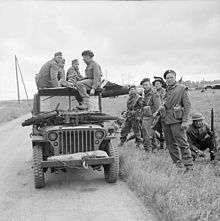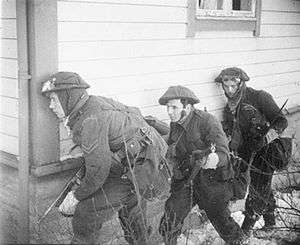Derek Mills-Roberts
Brigadier Derek Mills-Roberts, CBE, DSO and bar, MC (23 November 1908 – 1 October 1980) was a British commando who fought with the 1st Special Service Brigade during World War II. In a quirk of military history, he became the only Allied soldier to strike a German Field Marshall with the latter's own staff-of-office – when Mills-Roberts beat Erhard Milch over the head with the just-surrendered marshal's baton.
Derek Mills-Roberts | |
|---|---|
 Derek Mills – Roberts (foreground, standing) at the glider landing grounds near Ranville, 7 June 1944. | |
| Born | 23 November 1908 |
| Died | 1 October 1980 (aged 71) |
| Allegiance | |
| Service/ | British Army |
| Rank | Brigadier |
| Commands held | 1st Special Service Brigade |
| Awards | Commander of the Order of the British Empire, Distinguished Service Order and Bar, Military Cross, Legion D'Honneur, Croix de Guerre. |

Early life
Derek Mills-Roberts was born on 23 November 1908 in England. During the 1930s, he trained to become a lawyer at Liverpool College and the University of Oxford. On 3 October 1936, he was commissioned into the Irish Guards Supplementary Reserve of Officers as a second lieutenant, having been an officer cadet of the University of Oxford contingent of the Officer Training Corps.[1] It was at Oxford that Derek met his good friend Lord Lovat. Derek and Lord Lovat had actually got off on a bad start. They had a rivalry which involved a heated argument and an exchange of blows. From that time on however, they became close friends. After graduation from Oxford, Derek worked for his father's law firm.
World War II
Mills-Roberts began his military service in the No.4 Commando Unit. His good friend, Lord Lovat was given command of the unit, while Derek served as Second in Command. On 3 March 1941, Mills-Roberts, in the No. 4 Commando Unit, launched a raid on the German-occupied Lofoten Islands. In the successful raid, the commandos destroyed a significant number of fish-oil factories, petrol dumps and 11 ships. They also seized encryption equipment and codebooks. In addition to the destruction of materials, the commandos captured 216 German troops, and 315 Norwegians chose to accompany the commandos back to Britain. In August 1942, Derek was involved in the disastrous Dieppe Raid.[2] The raid, a small scale invasion mounted by Canadian infantry and British commandos against Adolf Hitler's Atlantic Wall, was a complete failure and the units involved suffered very heavily. Lovat and Mills-Roberts's involvement in the raid was to secure the opposing flanks of the landing area and to destroy coastal batteries. By October 1942, he was a lieutenant (temporary captain) (acting major).[2]
In late 1942, Mills-Roberts was promoted to Lieutenant-Colonel and given command of No.6 Commando Unit; he was then stationed in North Africa. During the Normandy landings in 1944 the unit captured the port of Ouistreham and linked up with the 6th Airborne Division on the eastern flank of Sword.
Later in the war, among other actions, he took part in the Bergen-Belsen concentration camp's liberation. When Luftwaffe Field Marshal Erhard Milch was captured and surrendered his command baton to Mills-Roberts, the latter vented his anger about the atrocities he had seen at Bergen-Belsen marching Milch around the camp and demanding to know his thoughts on the terrible sights witnessed. Milch's reply (who spoke English) was along the lines of 'these people are not human beings in the same way as you and I!' This infuriated Mills-Roberts who took Milch's Field Marshal's baton from under Milch's arm and broke it over his head. Mills-Roberts went to Montgomery the following day to apologise for losing his temper with a senior German officer and Montgomery put his hands over his head in mock protection jokingly saying 'I hear you've got a thing about Field Marshals' and nothing more was said. The broken pieces were retrieved by his batman and the remains were given to Mills-Robert's wife Jill who had the baton restored at Swayne Adeney Brigg in London but the replacement shaft was slightly longer than the original. In later years, Jill sold the baton at auction. Before the auction, an injunction was put on the sale by the Milch family who contested ownership saying that the baton was 'stolen' from Milch. A local magistrate in UK decided that the baton was legitimate war booty and the sale continued, the baton going to an American collector in Florida. By June 1945, he was a brigadier (temporary).[3]
Honours and decorations
Mills-Roberts was awarded the Military Cross on 2 October 1942 "in recognition of gallant and distinguished services in the combined attack on Dieppe".[2] He was awarded the Distinguished Service Order (DSO) on 22 April 1943 "in recognition of gallant and distinguished services in North Africa".[4] He was awarded a medal bar to his Distinguished Service Order (DSO and bar) on 21 June 1945 "in recognition of gallant and distinguished services in North-West Europe".[3] In the 1950 New Year Honours, he was appointed Commander of the Order of the British Empire (CBE).[5]
- Commander of the Order of the British Empire
- Distinguished Service Order and Bar
- Military Cross
- Légion d'honneur
- Croix de Guerre
References
- "No. 34328". The London Gazette. 2 October 1936. p. 6277.
- "No. 35729". The London Gazette (Supplement). 2 October 1942. p. 4328.
- "No. 37138". The London Gazette (Supplement). 19 June 1945. p. 3231.
- "No. 35987". The London Gazette (Supplement). 20 April 1943. p. 1846.
- "No. 39104". The London Gazette (Supplement). 29 December 1950. p. 6.